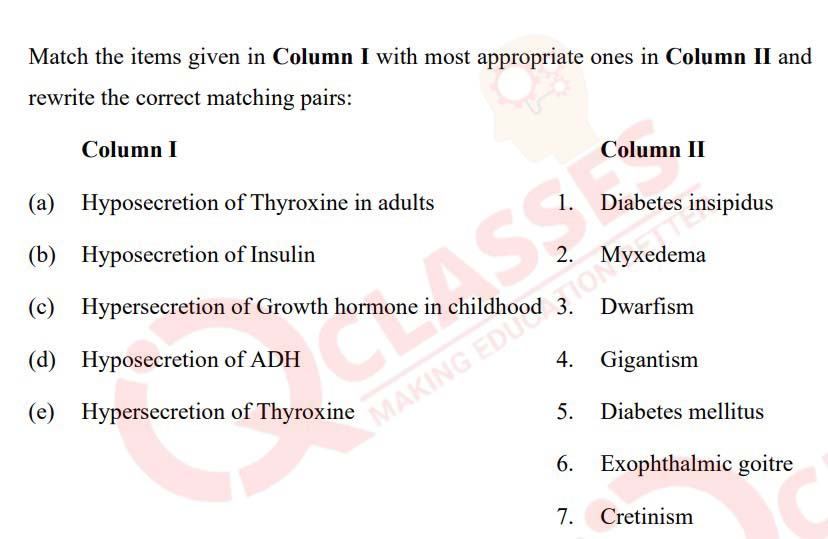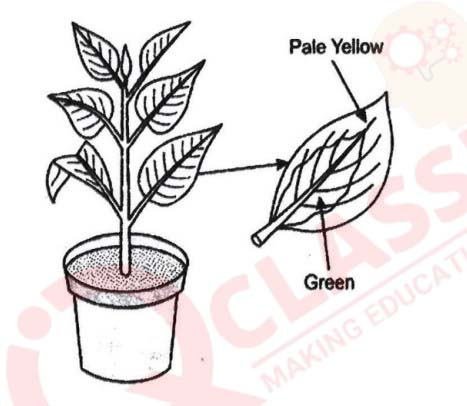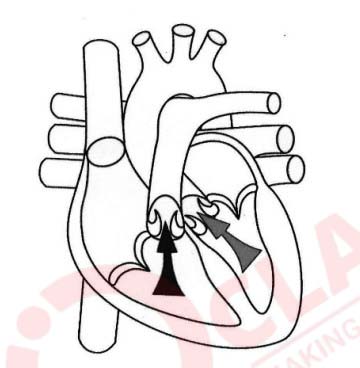Maximum Marks: 80
Time allowed: Two and half hours
Answers to this Paper must be written on the paper provided separately.
You will not be allowed to write during first 15 minutes.
This time is to be spent in reading the question paper.
The time given at the head of this Paper is the time allowed for writing the answers.
Section-A
(Attempt all questions from this Section.)
Question 1
Choose one correct answer to the questions from the given options:
(i) The sex chromosome in a human ovum is:
(a) X chromosome
(b) Y chromosome
(c) Both X and Y chromosomes
(d) Either X or Y chromosome
Solution
View Solution
(ii) Which one of the following is a biodegradable waste?
(a) Metal cans
(b) E-waste
(c) Plastic
(d) Flowers
Solution
View Solution
(iii) The heart sound ‘Dup’ is produced when:
(a) Semilunar valves open
(b) Atrio ventricular valves close
(c) Semilunar valves close
(d) Atrio ventricular valves open
Solution
View Solution
(iv) Deplasmolysis occurs when a plasmolysed cell is placed in:
(a) Concentrated salt solution
(b) Tap water
(c) Concentrated sugar solution
(d) Hypertonic salt solution
Solution
View Solution
(v) Alpha cells of Pancreas secrete:
(a) Glycogen
(b) Glucose
(c) Glucagon
(d) Insulin
Solution
View Solution
(vi) Haploid number of chromosomes are found in:
(a) Nephrons
(b) Neurons
(c) Skin cells
(d) Sperms
Solution
View Solution
(vii) The life span of an RBC is:
(a) 120 days
(b) 220 days
(c) 20 days
(d) 2 weeks
Solution
View Solution
(viii) The statistical study of human population is called:
(a) Mortality
(b) Demography
(c) Natality
(d) Equality
Solution
View Solution
(ix) The pale yellow colour of normal human urine is due to the pigment:
(a) Melanin
(b) Anthocyanin
(c) Urochrome
(d) Haemoglobin
Solution
View Solution
(x) Stimulation of the nerves of the sympathetic nervous system:
(a) Accelerates heartbeat
(b) Constricts pupil of eyes
(c) Increases peristalsis
(d) Retards heartbeat
Solution
View Solution
(xi) The site of light reaction in the cells of a green leaf is:
(a) Nucleus
(b) Grana of chloroplast
(c) Cytoplasm
(d) Stroma of chloroplast
Solution
View Solution
(xii) The paper used to demonstrate unequal transpiration in a dicot leaf is:
(a) Filter paper
(b) Litmus paper
(c) Starch paper
(d) Cobalt chloride paper
Solution
View Solution
(xiii) Vitreous humour is present between:
(a) Cornea and Iris
(b) Lens and Retina
(c) Iris and Lens
(d) Cornea and Lens
Solution
View Solution
(xiv) Oxygenated blood to liver is supplied by:
(a) Hepatic artery
(b) Hepatic vein
(c) Inferior venacava
(d) Hepatic portal vein
Solution
View Solution
(xv) During the synthesis phase of the cell cycle, more of:
(a) RNA is synthesised
(b) RNA and proteins are synthesised
(c) DNA is synthesised
(d) Glucose is synthesized
Solution
View Solution
Question 2
(i) Name the following:
(a) The organelle that forms the aster during cell division.
(b) A genetic disorder in which the blood does not clot.
(c) The permanent stoppage of menstruation in human females around the age of
45 years.
(d) The openings on the barks of trees through which transpiration occurs.
(e) A gaseous plant hormone which promotes ripening of fruits.
(ii) Arrange and rewrite the terms in each group in correct order to be in a logical
sequence beginning with the term that is underlined:
(a) Snake, Rabbit, Cabbage, Hawk.
(b) Xylem, Soil water, Cortical cells, Root hair.
(c) Receptor, Response, Effector, Spinal Cord
(d) Fovea, Lens, Cornea, Conjunctiva.
(e) Testis, Urethra, Sperm duct, Epididymis
(iii)

(iv) Choose the odd one out from the following terms and name the category to which
the others belong:
(a) Used bandages, Pesticides, Face masks, Syringes.
(b) Dust, Smoke, Carbon monoxide, Effluents
(c) Uterus, Urethra, Urinary bladder, Ureter
(d) Menstrual phase, Telophase, Follicular phase, Luteal phase
(e) Malleus, Incus, Cochlea, Stapes
(v) State the exact location of the following structures:
(a) Thyroid gland
(b) Dura mater
(c) Amniotic fluid
(d) Papillary muscles
(e) Islets of Langerhans
Solution
View Solution
Section-B
(Attempt any four questions from this Section.)
Question 3
(i) Write the overall chemical equation for photosynthesis.
(ii) Mention any two functions of blood.
(iii) Differentiate between Karyokinesis and Cytokinesis.
(iv) Excessive use of fertilizers in agricultural fields reduces the yield of crops.
Justify the statement.
(v) Study the diagram given below and answer the questions that follow:

(a) Name the phenomenon depicted by the shoot in the above diagram.
(b) Which plant hormone plays an important role in the above movement?
(c) Complete and rewrite the given statement by filling in the correct terms:
Shoots show positive _________ whereas, roots show positive __________
Solution
View Solution
Question 4
(i) Expand the abbreviation – DNA.
(ii) What is Active transport?
(iii) Mention the two pairs of nitrogenous bases which pair with each other with
hydrogen bonds.
(iv) State Mendel’s ‘Law of Segregation’.
(v) Draw a neat, labelled diagram of a human sperm
Solution
View Solution
Question 5
(i) Explain the term ‘Population density’.
(ii) Name the two surgical methods of population control.
(iii) Mention two factors responsible for population explosion in India.
(iv) Name any two resources which come under pressure due to rising population.
(v) The diagram given below depicts the climate change on planet Earth.
Answer the following question

(a) Name the climatic phenomenon for the increase in Earth’s temperature.
(b) Mention one reason for this warming.
(c) What measure can be taken to prevent this climate change?
Solution
View Solution
Question 6
(i) Define the term Transpiration.
(ii) State any two adaptations in plants to reduce transpiration.
(iii) Mention any two functions of the human foetal placenta.
(iv) What is the significance of the human testes being located in scrotal sacs outside the
abdomen?
(v) Draw a neat, labelled diagram of a Malpighian Capsule.
Solution
View Solution
Question 7
(i) What is a Reflex action?
(ii) Renal cortex has a dotted appearance and Renal medulla has a striped appearance.
Explain.
(iii) What are the two functions of cerebellum.
(iv) Distinguish between Semicircular canals and Utriculus based on their function.
(v) A potted plant with variegated leaves was kept in dark for 24 hours and then placed
in bright sunlight. Answer the following questions

(a) Which aspect of photosynthesis is being tested in the above diagram?
(b) Why was the plant kept in dark for 24 hours?
(c) After the starch test what will be the colour of the yellow and green parts of
the leaf? Give reasons to support your answer.
Solution
View Solution
Question 8
(i) Define the term Mutation.
(ii) A pure breeding red flower variety of pea plant (RR) is crossed with a pure breeding
white flower variety of pea plant (rr).
Draw a Punnett square to find out the Phenotypic and Genotypic ratios of the
progeny belonging to the F2 generation.
(iii) Leaves of certain plants roll up on a hot sunny day.
Explain by giving suitable reasons.
(iv) What is a semi permeable membrane?
Name the semi permeable membrane present in a plant cell.
(v) The diagram below depicts the human heart in one of its phases.
Answer the questions that follow:

(a) Which part of the heart is in the contraction phase?
(b) Give a suitable reason to justify your answer in (a).
(c) Distinguish between Systole and Diastole
Solution
View Solution




